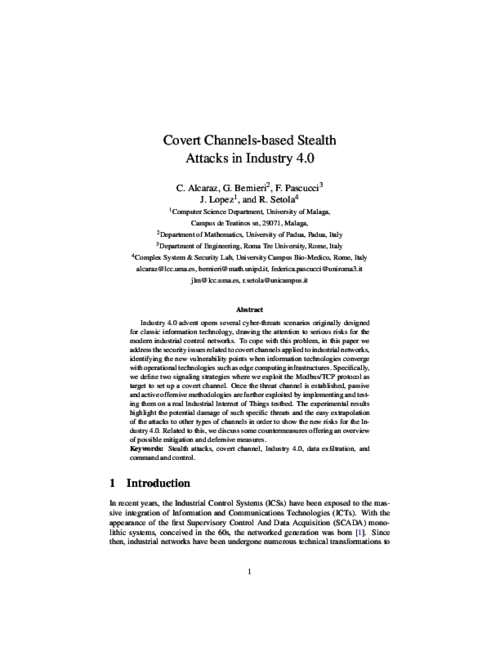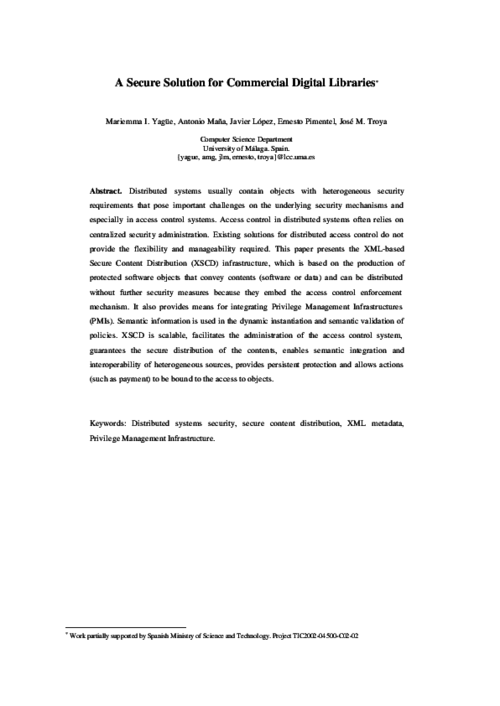 ]
] Novática, vol. 134, pp. 20-26, 1998.
Abstract
La seguridad es uno de los aspectos más conflictivos del uso de Internet. La falta de una política de seguridad global está frenando el desarrollo de Internet en áreas tan interesantes y prometedoras como el comercio electrónico o la interacción con las administraciones públicas. Las técnicas criptográficas actuales proporcionan un alto grado de confidencialidad; no obstante, es difícil garantizar la identificación segura de los usuarios y, además, la gestión de las claves de los mismos es poco eficiente y presenta graves problemas de escalabilidad y seguridad. En este trabajo se describe una solución a ambos problemas basada en una Infraestructura de Clave Pública que proporciona una administración simple y eficiente de las claves de los usuarios y posibilita la autenticación segura de los mismos. El sistema se ha probado con éxito de forma local y, en breve, será instalado para su prueba por parte de la comunidad de usuarios de RedIris.
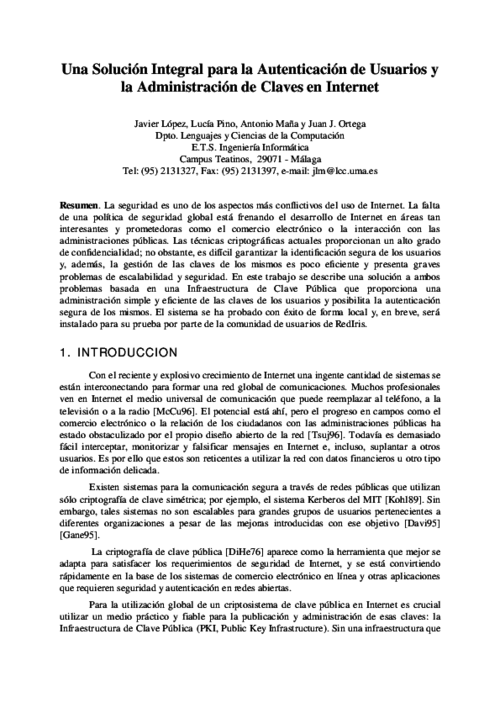
International Journal of Information Security, vol. 2, no. 1, Springer, pp. 21-36, 2003.
Abstract
We present the adaptation of our model for the validation of key distribution and authentication protocols to address some of the specific needs of protocols for electronic commerce. The two models defer in both the threat scenario and in the protocol formalization. We demonstrate the suitability of our adaptation by analyzing a specific version of the Internet Billing Server protocol introduced by Carnegie MellonUniversity. Our analysis shows that, while the security properties a key distribution or authentication protocol shall provide are well understood, it is often not clear which properties an electronic commerce protocol can or shall provide. We use the automatic theorem proving software ‘‘Otter’’ developed at Argonne National Laboratories for state space exploration.
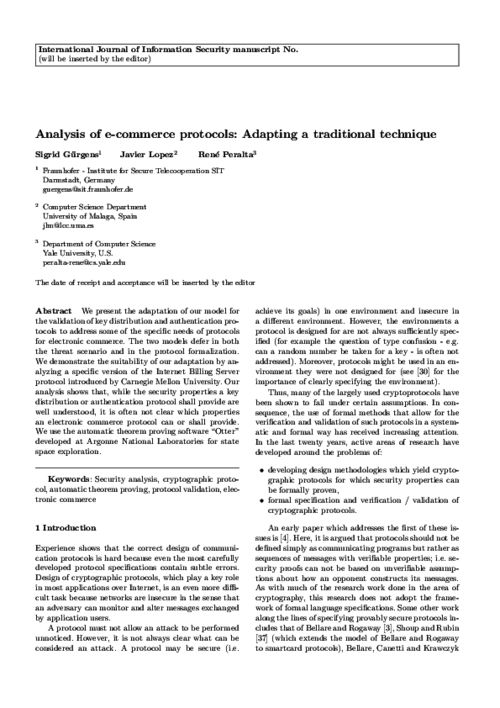
Online Information Review Journal, vol. 27, no. 3, Emerald, pp. 147-159, 2003.
Computers & Security, vol. 23, no. 7, Elsevier, pp. 578-590, 2004.
Abstract
In this article, we argue that traditional approaches for authorization and access control in computer systems (i.e., discretionary, mandatory, and role-based access controls) are not appropriate to address the requirements of networked or distributed systems, and that proper authorization and access control requires infrastructural support in one way or another. This support can be provided, for example, by an authentication and authorization infrastructure (AAI). Against this background, we overview, analyze, discuss, and put into perspective some technologies that can be used to build and operate AAIs. More specifically, we address Microsoft .NET Passport and some related activities (e.g. the Liberty Alliance Project), Kerberos-based solutions, and AAIs that are based on digital certificates and public key infrastructures (PKIs). We conclude with the observation that there is no single best approach for providing an AAI, that every approach has specific advantages and disadvantages, and that a comprehensive AAI must combine various technologies and approaches.
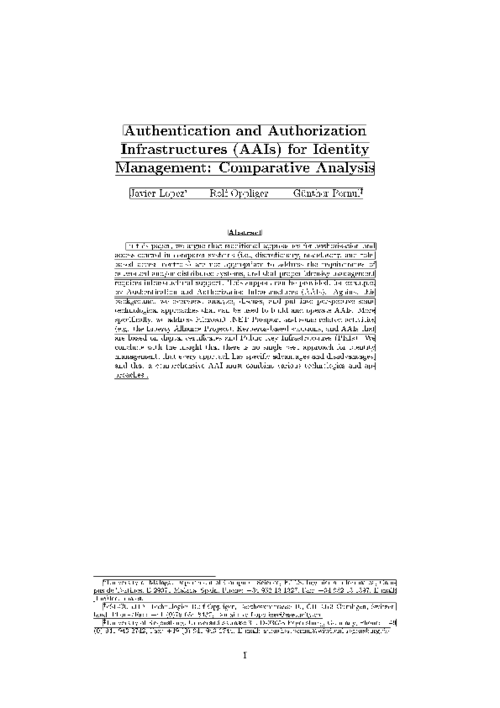
International Journal of Information Security (IJIS), vol. 3, no. 2, Springer, pp. 99-112, 2004.
Abstract
The protection of software applications is one of the most important problems to solve in information security because it has a crucial effect on other security issues.We can find in the literature many research initiatives that have tried to solve this problem, many of them based on the use of tamperproof hardware tokens. This type of solutions depends on two basic premises: (i) to increase the physical security by using tamperproof devices, and (ii) to increase the complexity of the analysis of the software. The first premise is reasonable. The second one is certainly related to the first one. In fact, its main goal is that the pirate user can not modify the software to bypass an operation that is crucial: checking the presence of the token. However, the experience shows that the second premise is not realistic because the analysis of the executable code is always possible. Moreover, the techniques used to obstruct the analysis process are not enough to discourage an attacker with average resources. In this paper, we review the most relevant works related to software protection, present a taxonomy of those works and, most important, we introduce a new and robust software protection scheme. This solution, called SmartProt, is based on the use of smart cards and cryptographic techniques, and its security relies only on the first of previous premises; that is, Smartprot has been designed to avoid attacks based on code analysis and software modification. The entire system is described following a lifecycle approach, explaining in detail the card setup, production, authorization, and execution phases. We also present some interesting applications of Smart- Prot as well as the protocols developed to manage licenses. Finally, we provide an analysis of its implementation details.
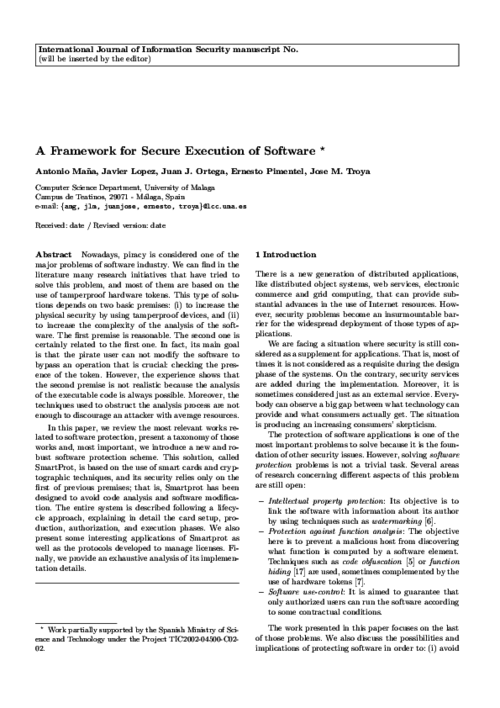
International Journal of Computer Systems, Science & Engineering, vol. 20, no. 6, CRL Publishing, 2005.
Abstract
An important aspect of e-business is the area of e-commerce. According to recent surveys, one of the most severe restraining factors for the proliferation of e-commerce, as measured by the gap between predicted market value and actual development is the (lack of) security measures required to assure both businesses and customers that their business relationship and transactions will be carried out in privacy, correctly, and timely. A large number of individuals are not willing to engage in e-commerce (or are only participating at a reduced level) simply because they do not trust the e-commerce sites and the underlying information and communication technologies to be secure enough. This paper first considers privacy and security requirements for e-commerce applications; it then discusses methods and technologies that can be used to fulfil these requirements.
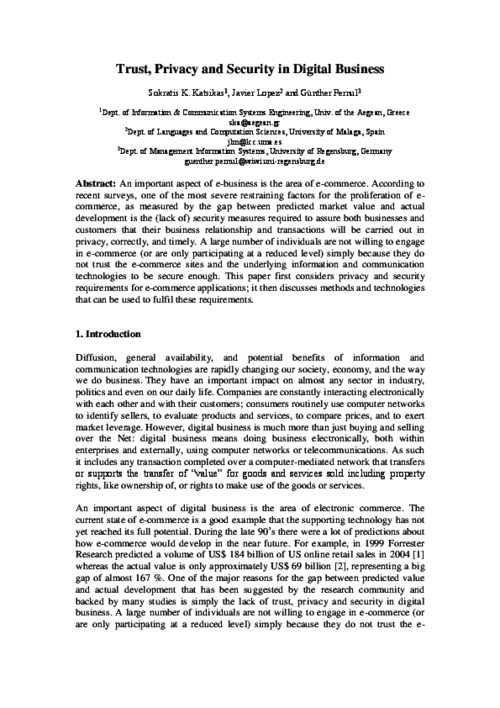
Internet Research, vol. 15, no. 5, Emerald, pp. 544-556, 2005.
Abstract
Since public key cryptography is a fundamental technology for electronic commerce, people have often argued that public key infrastructures and corresponding certification services are the gold-mines of the information age. Contrary to these relatively high expectations, public key infrastructures have not really taken off and many certification service providers have even gone out of business. In this paper, we overview and discuss the technical, economical, legal, and social reasons why public key infrastructures have failed so far, summarize the lessons learnt, and give our expectations about the future development of the field.
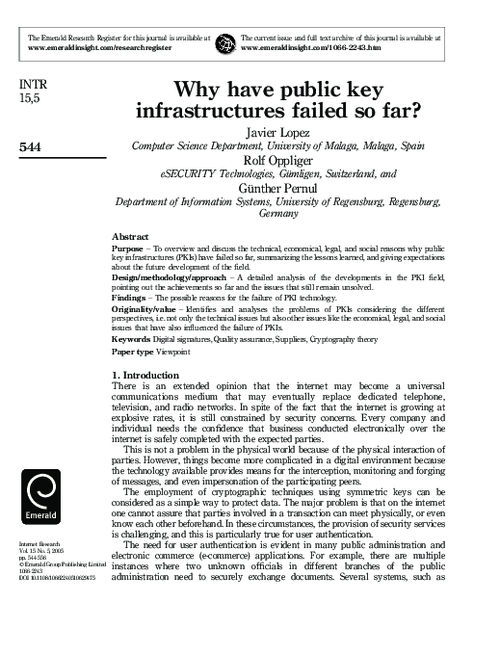
Information and Software Technology, vol. 52, Elsevier, pp. 517-536, May 2010. DOI
Abstract
Developing software through systematic processes is becoming more and more important due to the growing complexity of software development. It is important that the development process used integrates security aspects from the first stages at the same level as other functional and non-functional requirements. Systems which are based on Grid Computing are a kind of systems that have clear differentiating features in which security is a highly important aspect. The Mobile Grid, which is relevant to both Grid and Mobile Computing, is a full inheritor of the Grid with the additional feature that it supports mobile users and resources. A development methodology for Secure Mobile Grid Systems is proposed in which the security aspects are considered from the first stages of the life-cycle and in which the mobile Grid technological environment is always present in each activity. This paper presents the analysis activity, in which the requirements (focusing on the grid, mobile and security requirements) of the system are specified and which is driven by reusable use cases through which the requirements and needs of these systems can be defined. These use cases have been defined through a UML-extension for security use cases and Grid use cases which capture the behaviour of this kind of systems. The analysis activity has been applied to a real case.
Computers & Security, vol. 29, no. 2, pp. 167 - 179, 2010. DOI
Abstract
Certified electronic mail is an added value to traditional electronic mail. In the definition of this service some differences arise: a message in exchange for a reception proof, a message and a non repudiation of origin token in exchange for a reception proof, etc. It greatly depends on whether we want to emulate the courier service or improve the service in the electronic world. If the definition of the service seems conflictive, the definition of the properties and requirements of a good certified electronic mail protocol is even more difficult. The more consensuated features are the need of a fair exchange and the existence of a trusted third party (TTP). Each author chooses the properties that considers the most important, and many times the list is conditioned by the proposal. Which kind of TTP must be used? Must it be verifiable, transparent and/or stateless? Which features must the communication channel fulfil? Which temporal requirements must be established? What kind of fairness is desired? What efficiency level is required? Are confidentiality or transferability of the proofs compulsory properties? In this paper we collect the definitions, properties and requirements related with certified electronic mail. The aim of the paper is to create a clearer situation and analyze how some properties cannot be achieved simultaneously. Each protocol designer will have to decide which properties are the most important in the environment in where the service is to be deployed.
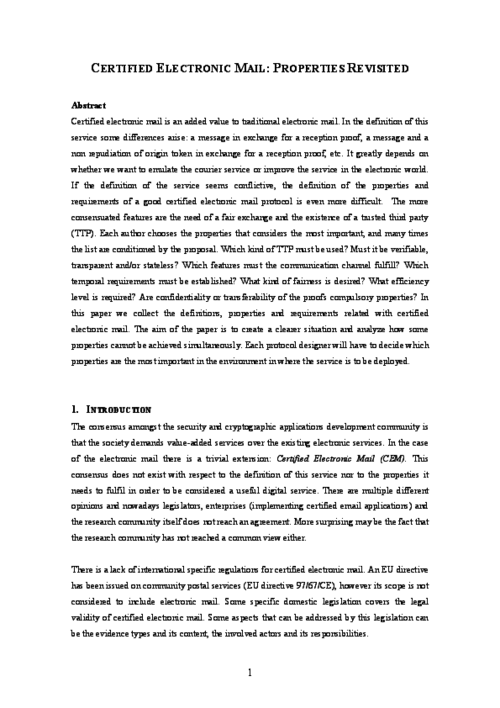
Journal of Universal Computer Science, vol. 16, no. 17, Springer, pp. 2333-2352, Sep 2010. DOI
Abstract
The idea of developing software through systematic development processes toimprove software quality is not new. Nevertheless, there are still many information systemssuch as those of Grid Computing which are not developed through methodologies that areadapted to their most differentiating features. A systematic development process for Gridsystems that supports the participation of mobile nodes and incorporates security aspects intothe entire software lifecycle will thus play a significant role in the development of systemsbased on Grid computing. We are creating a development process for the construction ofinformation systems based on Grid Computing, which is highly dependent on mobile devices,in which security plays a highly important role. One of the activities in this process is that ofanalysis which is focused on ensuring that the system’s security and functional requirements areelicited, specified and modelled. In our approach, this activity is driven by use cases andsupported by the reusable repository. This obtains, builds, defines and refines the use cases ofthe secure Mobile Grid systems which represent the functional and non-functional requirementsof this kind of systems. In this paper, we present the proposed development process throughwhich we introduce the main aspects of the UML profile defined for building use case diagramsin the mobile Grid context through which it is possible to represent specific mobile Gridfeatures and security aspects, showing in detail how to build use case diagrams for a real mobile Grid application by using our UML profile, denominated as GridUCSec-Profile.
Journal of Network and Computer Applications, vol. 34, Elsevier, pp. 1168-1183, 2011.
Abstract
Grid computing has arisen as an evolution of distributed systems mainly focused on the sharing of and remote access to resources in a uniform, transparent, secure, efficient and reliable manner. It is possible to join Grid technology and mobile technology in order to create one of the most promising technologies and developments to appear in recent years, in that they enrich one another and provide new solutions that solve many of the limitations and problems found in different technologies. Security is a very important factor in Mobile Grid Computing and is also difficult to achieve owing to the open nature of wireless networks and heterogeneous and distributed environments. Success in obtaining a secure system originates in incorporating security from the first stages of the development process. It has therefore been necessary to define a development process for this kind of systems in which security is incorporated in all stages of the development and the features and particularities of the Mobile Grid systems are taken into consideration. This paper presents one of the activities of this development process, the design activity, which consists of defining and designing a security software architecture. This architecture will be built from a security architecture, defined as reference architecture, in which security services, interfaces and operations are defined with the purpose of defining a reference security architecture which covers the majority of security requirements identified in the analysis activity. The design activity will build the system architecture that will be the input artefact for the subsequent activity in the process, which is the construction activity.
IEICE Trans. on Information and Systems, vol. E94-D, IEICE, pp. 243-254, Feb 2011. DOI
Abstract
The systematic processes exactly define the development cycle and help the development team follow the same development strategies and techniques, thus allowing a continuous improvement in the quality of the developed products. Likewise, it is important that the development process used integrates security aspects from the first stages at the same level as other functional and non-functional requirements. Grid systems allow us to build very complex information systems with different and remarkable features (interoperability between multiple security domains, cross-domain authentication and authorization, dynamic, heterogeneous and limited mobile devices, etc). With the development of wireless technology and mobile devices, the Grid becomes the perfect candidate for letting mobile users make complex works that add new computational capacity to the Grid. A methodology of development for secure mobile Grid systems is being defined. One of the activities of this methodology is the requirements analysis which is based in reusable use cases. In this paper, we will present a UML-extension for security use cases and Grid use case which capture the behaviour of this kind of systems. A detailed description of all these new use cases defined in the UML extension is necessary, describing the stereotypes, tagged values, constraints and graphical notation. We show an example of how to apply and use this extension for building the diagram of use cases and incorporating common security aspects for this kind of systems. Also, we will see how the diagrams built can be reused in the construction of others diagrams saving time and effort in this task.
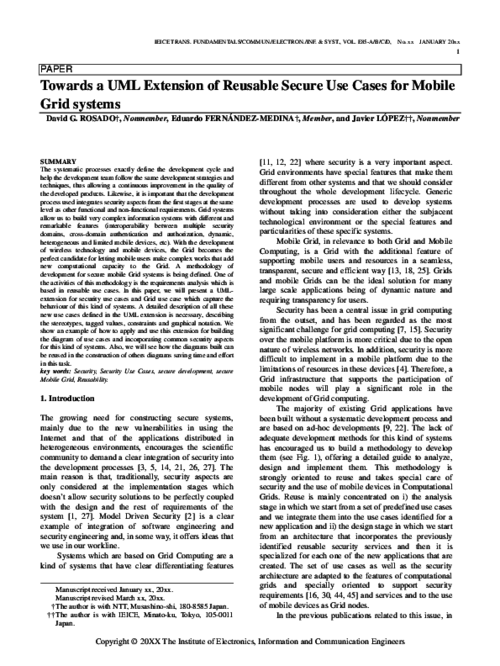
Wireless Personal Communications, vol. 73, Springer, pp. 23-50, Nov 2013, 2012. DOI
Abstract
The smart grid is an electronically controlled electrical grid that connects power generation, transmission, distribution, and consumers using information communication technologies. One of the key characteristics of the smart grid is its support for bi-directional information flow between the consumer of electricity and the utility provider. This two-way interaction allows electricity to be generated in real-time based on consumers’ demands and power requests. As a result, consumer privacy becomes an important concern when collecting energy usage data with the deployment and adoption of smart grid technologies. To protect such sensitive information it is imperative that privacy protection mechanisms be used to protect the privacy of smart grid users. We present an analysis of recently proposed smart grid privacy solutions and identify their strengths and weaknesses in terms of their implementation complexity, efficiency, robustness, and simplicity.
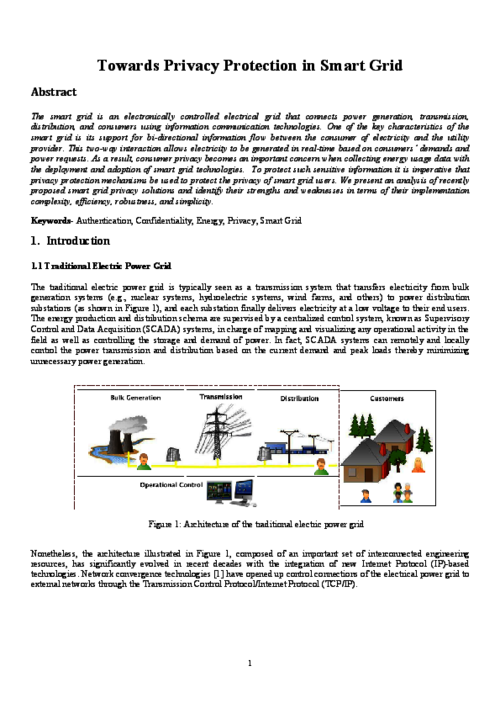
Mathematical and Computer Modelling, vol. 57, Elsevier, pp. 2583–2595, Jun 2013. DOI
Abstract
This work describes the design and implementation of an auction system using secure multiparty computation techniques. Our aim is to produce a system that is practical under actual field constraints on computation, memory, and communication. The underlying protocol is privacy-preserving, that is, the winning bid is determined without information about the losing bids leaking to either the auctioneer or other bidders. Practical implementation of the protocol is feasible using circuit-based cryptographic proofs along with additively homomorphic bit commitment. Moreover, we propose the development of a Proof Certificatestandard. These certificates convey sufficient information to recreate the cryptographic proofs and verify them offline.
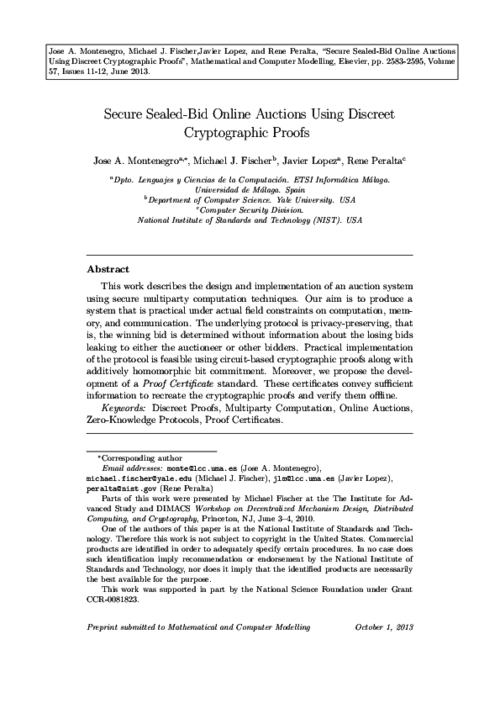
IEEE Communications Surveys and Tutorials, vol. 20, issue 4, IEEE, pp. 3453-3495, 07/2018. DOI
Abstract
As the deployment of Internet of Things (IoT) is experiencing an exponential growth, it is no surprise that many recent cyber attacks are IoT-enabled: The attacker initially exploits some vulnerable IoT technology as a first step towards compromising a critical system that is connected, in some way, with the IoT. For some sectors, like industry, smart grids, transportation and medical services, the significance of such attacks is obvious, since IoT technologies are part of critical backend systems. However, in sectors where IoT is usually at the enduser side, like smart homes, such attacks can be underestimated, since not all possible attack paths are examined. In this paper we survey IoT-enabled cyber attacks, found in all application domains since 2010. For each sector, we emphasize on the latest, verified IoT-enabled attacks, based on known real-world incidents and published proof-of-concept attacks. We methodologically analyze representative attacks that demonstrate direct, indirect and subliminal attack paths against critical targets. Our goal is threefold: (i) To assess IoT-enabled cyber attacks in a risk-like approach, in order to demonstrate their current threat landscape; (ii) To identify hidden and subliminal IoT-enabled attack paths against critical infrastructures and services, and (iii) To examine mitigation strategies for all application domains.
IEEE Systems Journal., vol. 13, issue 4, IEEE, pp. 3980-3988, 12/2019. DOI
Abstract
Industry 4.0 advent opens several cyber-threats scenarios originally designed for classic information technology, drawing the attention to the serious risks for the modern industrial control networks. To cope with this problem, in this paper we address the security issues related to covert channels applied to industrial networks, identifying the new vulnerability points when information technologies converge with operational technologies such as edge computing infrastructures. Specifically, we define two signaling strategies where we exploit the Modbus/TCP protocol as target to set up a covert channel. Once the threat channel is established, passive and active offensive attacks (i.e. data exfiltration and command an control, respectively) are further exploited by implementing and testing them on a real Industrial Internet of Things testbed. The experimental results highlight the potential damage of such specific threats, and the easy extrapolation of the attacks to other types of channels in order to show the new risks for Industry 4.0. Related to this, we discuss some countermeasures to offer an overview of possible mitigation and defense measures.
